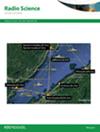闪烁诊断的相屏模型
IF 1.5
4区 地球科学
Q3 ASTRONOMY & ASTROPHYSICS
引用次数: 0
摘要
先进的全球导航卫星系统接收机通常报告强度闪烁指数、相位闪烁指数和总电子含量变化率指数(ROTI)。正在积累广泛的区域测量数据,并作为诊断资源提供。虽然每个参数都独立于测量的强度和相位时间序列,但电离层结构是闪烁表现的来源,更明确的闪烁诊断可以预测由双分量逆幂律谱密度函数表征的结构。本文对经过二维随机相位屏传播时被随机调制的信号幅度和相位的主要统计特性进行了理论预测。提出了一种不规则参数估计方法,可产生最大似然参数估计。结果表明,估计参数与理论预测相符,精度合理。用相屏模拟验证了理论预测。闪烁模型嵌入到具有加性噪声的通用信号模型中,从而可以直接应用于适当的去趋势强度和相位测量。本文章由计算机程序翻译,如有差异,请以英文原文为准。
On phase screen models for scintillation diagnostics
Advanced global navigation satellite system receivers typically report intensity scintillation indices, phase scintillation indices, and rate of total electron content change indices (ROTI). Extensive regional measurements are being accumulated and made available as diagnostic resources. Although each parameter is derived independently from measured intensity and phase time series, to the extent that ionospheric structure is the source of the scintillation manifestations, more definitive scintillation diagnostics can be predicted for structure characterized by a two-component inverse power law spectral density function. This paper derives theoretical predictions of main statistical characteristics of signal amplitude and phase that has been randomly modulated while propagating through two-dimensional random phase screens. An irregularity parameter estimation procedure is developed that generates maximum likelihood parameter estimates. It is shown that the estimated parameters reconcile theoretical prediction with reasonable accuracy. Phase-screen simulations are used to verify the theoretical predictions. The scintillation model is embedded in a generic signal model with additive noise, which allows direct application to appropriately detrended intensity and phase measurements.
求助全文
通过发布文献求助,成功后即可免费获取论文全文。
去求助
来源期刊

Radio Science
工程技术-地球化学与地球物理
CiteScore
3.30
自引率
12.50%
发文量
112
审稿时长
1 months
期刊介绍:
Radio Science (RDS) publishes original scientific contributions on radio-frequency electromagnetic-propagation and its applications. Contributions covering measurement, modelling, prediction and forecasting techniques pertinent to fields and waves - including antennas, signals and systems, the terrestrial and space environment and radio propagation problems in radio astronomy - are welcome. Contributions may address propagation through, interaction with, and remote sensing of structures, geophysical media, plasmas, and materials, as well as the application of radio frequency electromagnetic techniques to remote sensing of the Earth and other bodies in the solar system.
 求助内容:
求助内容: 应助结果提醒方式:
应助结果提醒方式:


